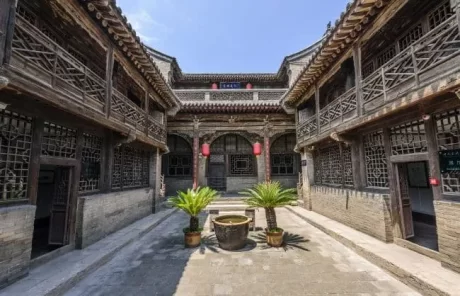Shanxi Travel Guide: Plan a Perfect Trip to Shanxi
Shanxi Province is an inland province in China, located on the east bank of the middle Yellow River and the loess plateau to the west of the North China Plain. As an ancient province bearing 5,000 years of Chinese civilization, Shanxi is known worldwide for its rich history and unique cultural heritage. Just as the saying goes, “To see underground cultural relics, look at Shaanxi; to see above-ground cultural relics, look at Shanxi.”
Though famous for its coal, Shanxi also greets visitors with many Buddhist temples, pagodas, and grottoes, all of which feature unique architectural styles and exquisite carvings. Residences and ancient buildings with diverse styles and forms can be seen on your Shanxi tours as well. Besides, the Shanxi Rift System in Pinglu and Shanxi black granite attract many geologists to research.

Chinese: 山西 shān xī
Location: Northern China
Population (urban area): 34,814,000
Why Visit Shanxi?
- Cultural and Historical Heritage: Shanxi has 452 important national cultural relics, which is the most in China, including the UNESCO World Heritage Site of Pingyao Ancient City, the Yungang Grottoes, and Mount Wutai.
- Breathtaking Landscapes: Located in the west of Taihang Mountain with Fen River, Qin River, and many other rivers running through it, Shanxi boasts many natural attractions to explore. Here, you’ll see the majestic Taihang Grand Valley in Changzhi of Shanxi, the magnificent Hukou Waterfall, the charming Mount Wutai, and the sacred Mount Heng.
- Ancient Courtyard Residences: Shanxi is also famous for its ancient residential buildings with diverse styles from different dynasties. The Qiao Family Compound and the Wang Family Compound are among the representatives of traditional Chinese residences, where you can see meticulous layouts and exquisite decorations.
Top Travel Destinations in Shanxi
Top Things to Do in Shanxi
1. Explore the Pingyao Ancient City
Located in central Shanxi, Pingyao Ancient City is a must-visit attraction during your Pingyao Tours. It is a UNESCO World Heritage Site and is the most well-preserved ancient city in China today. The entire city resembles a turtle crawling southward, earning it the nickname “Turtle City.” Touring there, you can take a stroll along the ancient city wall, and visit the ancient Pingyao County Government Office, Pingyao Confucian Temple, and Rishengchang Draft Bank Former Site.
Classic Shanxi Tours including Pingyao Ancient City
2. Discover the Yungang Grottoes
Never miss Yungang Grottoes on your Datong Tours in Shanxi. As one of the most grottoes in China, Yungang Grottoes are carved into the mountains, with a grand scale and imposing grandeur, stretching about 1 kilometer from east to west. Currently, there are about 1,100 niches and over 59,000 statues, the largest statues reach up to 17 meters in height, while the smallest are just 2 centimeters.
Highlighted Shanxi Tours including Yungang Grottoes
- 5 Days Shanxi Essence Tour of Pingyao-Taiyuan-Datong
- 10 Days Historic China Tour of Xi’an-Pingyao-Datong-Beijing
3. Hike Mount Wutai
Also known as the “Golden Wutai,” Mount Wutai in Shanxi is one of the Four Sacred Mountains of Chinese Buddhism and is dedicated to the Bodhisattva Manjushri. With the highest peak reaching 3,061 meters, Mount Wutai has five main peaks and is a paradise for hikers. The summits are flat and expansive, with few trees planted, from where you can overlook the whole mountain range.
Popular Shanxi Tours including Mount Wutai
4. Marvel at the Hanging Temple
Established during the late Northern Wei period, the Hanging Temple of Shanxi is over 1,500 years old. It is a unique temple that integrates Buddhism, Taoism, and Confucianism. Built on the cliff face, the Hanging Temple boasts highly distinctive architecture, famous for its dramatic location, giving the impression of hanging over an abyss. Visiting there, you’ll marvel at its remarkable construction.
Recommended Shanxi Tours including Hanging Temple
5. Visit the Magnificent Hukou Waterfall
Hukou Waterfall is the second-largest waterfall in China and the largest yellow waterfall in the world. The water plunges from a cliff over 20 meters high with a flow rate of 1,000 cubic meters per second. Besides, accompanying the waterfall are a series of unique and spectacular sights, collectively known as the “Eight Great Wonders.” Never miss them on your travel to Shanxi.
6. Tour the Qiao Family Compound
The Qiao Family Compound is an ancient residence that exemplifies the traditional architectural style of residential buildings from the Qing Dynasty in China. The entire complex consists of six large courtyards and 20 smaller ones, with a total of 313 rooms and a construction area of 4,175 square meters. Touring there, you’ll better understand the culture of Shanxi merchants and the folk traditions of northern Han Chinese.
Read more about the Top Things to Do in Shanxi
Basic History of Shanxi
With the Great Wall to the north and the Yellow River to the south, Shanxi is one of the birthplaces of the Chinese nation and the cradle of ancient civilization. During the Spring and Autumn and Warring States periods, it was part of the State of Jin, hence its abbreviation “Jin.” In 453 BCE, the State of Jin was divided among the Han, Zhao, and Wei families, which also gave rise to the name “Three Jin.”
In the late Sui dynasty, Taiyuan became the launching point for the rise of the Tang dynasty, thus earning Taiyuan the moniker “Dragon City.” During the Ming and Qing dynasties, the Shanxi merchants emerged, turning places like Pingyao and Taigu into financial centers of China.

Shanxi Weather
Located in the mid-latitude inland area, Shanxi experiences a temperate continental climate characterized by distinct seasons, simultaneous rain and heat, and ample sunlight. There are significant climate differences between the north and south as well as large temperature variations between winter and summer. The annual average temperature across the region ranges from 4.2 to 14.2°C, generally increasing from north to south and decreasing from basins to mountains.
The best time to visit Shanxi is in spring and autumn when the weather is mild and pleasant for outdoor activities and touring historical and cultural sites. Besides, if you plan to visit Moun Wutai, then summer will be the best time to go, during which the climate on the mountain is cool and the surroundings are beautiful.
Read more about Shanxi Weather
Shanxi Transportation
How to Get to Shanxi
By air: Shanxi has seven airports in total, among which the Taiyuan Wusu International Airport is the biggest and most frequently used one. It operates over 130 airlines connecting 72 cities and offers flights to Shanxi from major cities in China, including Beijing, Shanghai, Guangzhou, and Xi’an, as well as some international destinations like Saint Petersburg, Moscow, and Nha Trang.
By train: As an important railway transportation hub in North China, Shanxi has an extensive railway network, with high-speed trains connecting major cities within the province and to other parts of China. By the way, Taiyuan is the main railway hub of the province, with direct trains to Beijing, Shanghai, Xi’an, and other major cities.
By bus: Shanxi has a well-developed bus network, with regular bus services connecting major cities and towns within the province and to neighboring regions. For instance, a 5-hour long-distance bus is available for getting from Beijing to Mount Wutai in Shanxi.
High-speed trains are good options to travel between Datong, Pingyao, and Taiyuan, while buses are more suitable for visiting Mount Wutai. As for touring attractions located far from the city center, such as Wang’s Family Compound in Shanxi’s Pingyao, taking a taxi tends to be a more convenient way.
Taiyuan – Datong: It’s about 280km, and takes about 1-2.5 hours by high-speed train and 5-7 hours by long-distance bus.
Datong – Pingyao: It’s about 390km, and takes 3.5 hours by high-speed train and 3.5 hours by long-distance bus.
Taiyuan – Pingyao: It’s about 100km, and takes 30-40 minutes by high-speed train and 2-3 hours by long-distance bus.

Tips for Traveling in Shanxi
- Shanxi cuisinefeatures noodle-based foods, earning it the reputation of “a hundred ways to eat noodles.” Shanxi knife-cut noodles, Fried Boiled Pork, and Puffed Oil Cake are representatives of Shanxi food, don’t hesitate to try them all.
- For visitors who do not want to change hotels in Shanxitravel due to heavy luggage, you base yourself in Taiyuan, because it’s convenient to get to nearby cities and attractions.
- Except for architectural marvels, there are also living fossils to appreciate in the Shanxi Museumand vivid plays to see in the Shanxi Grand Theater. If you have a kid with you, never miss them.









